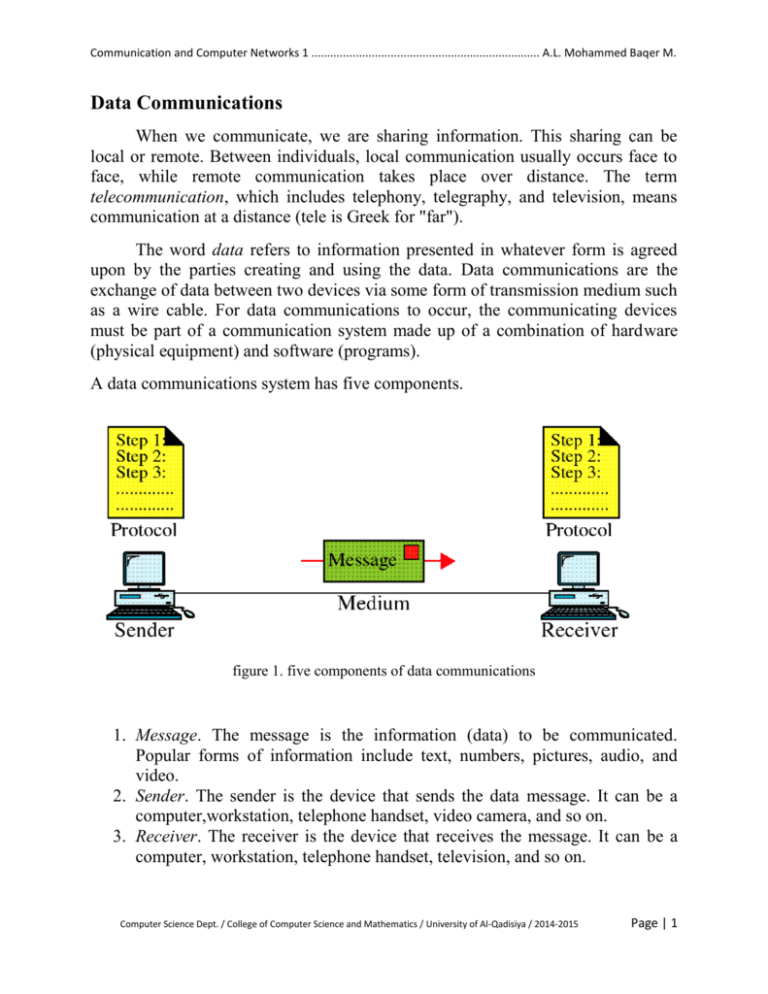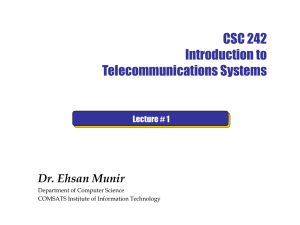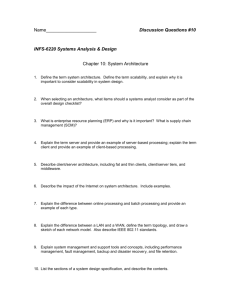Data Communications
advertisement

Communication and Computer Networks 1 ........................................................................ A.L. Mohammed Baqer M. Data Communications When we communicate, we are sharing information. This sharing can be local or remote. Between individuals, local communication usually occurs face to face, while remote communication takes place over distance. The term telecommunication, which includes telephony, telegraphy, and television, means communication at a distance (tele is Greek for "far"). The word data refers to information presented in whatever form is agreed upon by the parties creating and using the data. Data communications are the exchange of data between two devices via some form of transmission medium such as a wire cable. For data communications to occur, the communicating devices must be part of a communication system made up of a combination of hardware (physical equipment) and software (programs). A data communications system has five components. figure 1. five components of data communications 1. Message. The message is the information (data) to be communicated. Popular forms of information include text, numbers, pictures, audio, and video. 2. Sender. The sender is the device that sends the data message. It can be a computer,workstation, telephone handset, video camera, and so on. 3. Receiver. The receiver is the device that receives the message. It can be a computer, workstation, telephone handset, television, and so on. Computer Science Dept. / College of Computer Science and Mathematics / University of Al-Qadisiya / 2014-2015 Page | 1 Communication and Computer Networks 1 ........................................................................ A.L. Mohammed Baqer M. 4. Transmission medium. The transmission medium is the physical path by which a message travels from sender to receiver. Some examples of transmission media include twisted-pair wire, coaxial cable, fiber-optic cable, and radio waves. 5. Protocol. A protocol is a set of rules that govern data communications. It represents an agreement between the communicating devices. Without a protocol, two devices may be connected but not communicating, just as a person speaking French cannot be understood by a person who speaks only Japanese. Networks A network is a set of devices (often referred to as nodes) connected by communication links. A node can be a computer, printer, or any other device capable of sending and/or receiving data generated by other nodes on the network. Type of Networks Computers can be positioned on a network in different ways relative to each other. They can have different levels of control over shared resources. They can also be made to communicate and share resources according to different schemes. The following sections describe two fundamental network models: peer-to-peer and client/server. The simplest form of a network is a peer-to-peer network. In a peer-to-peer network, every computer can communicate directly with every other computer. By default, no computer on a peer-to-peer network has more authority than another. The advantages of using traditional peer-to-peer networks are: They are simple to configure. They are typically less expensive to set up and maintain than other types of networks. The main disadvantage of peer-to-peer network is that they are not necessarily secure—meaning that in simple installations, data and other resources shared by network users can be easily discovered and used by unauthorized people. Computer Science Dept. / College of Computer Science and Mathematics / University of Al-Qadisiya / 2014-2015 Page | 2 Communication and Computer Networks 1 ........................................................................ A.L. Mohammed Baqer M. Another way of designing a network is to use a central computer, known as a server, to facilitate communication and resource sharing between other computers on the network, which are known as clients. Clients usually take the form of personal computers, also known as workstations. Usually, servers have more memory, processing, and storage capacity than clients. Although client/server networks are typically more complex in their design and maintenance than peer-to-peer networks, they offer many advantages over peer-to-peer networks, such as: Access to multiple shared resources (such as data files or printers) can be centrally granted to a single user or groups of users. Problems on the network can be tracked, diagnosed, and often fixed from one location. Servers are optimized to handle heavy processing loads and dedicated to handling requests from clients, enabling faster response time. Type of Connection A network is two or more devices connected through links. A link is a communications pathway that transfers data from one device to another. For visualization purposes, it is simplest to imagine any link as a line drawn between two points. For communication to occur, two devices must be connected in some way to the same link at the same time. There are two possible types of connections: point-to-point and multipoint. 1. Point-to-Point A point-to-point connection provides a dedicated link between two devices. The entire capacity of the link is reserved for transmission between those two devices. When you change television channels by infrared remote control, you are establishing a point-to-point connection between the remote control and the television's control system. 2. Multipoint A multipoint (also called multidrop) connection is one in which more than two specific devices share a single link. Transmission mode The term transmission mode is used to define the direction of signal flow between two linked devices. There are three types of transmission modes: simplex, half-duplex and full-duplex. Computer Science Dept. / College of Computer Science and Mathematics / University of Al-Qadisiya / 2014-2015 Page | 3 Communication and Computer Networks 1 ........................................................................ A.L. Mohammed Baqer M. Simplex: In simplex mode, the communication is unidirectional as on one way street. Only one of two stations on a link can transmit; the other can only receive. Ex: such as monitor. Half-duplex In half-duplex mode, each station can both transmit and receive but not at the same time. When one device is sending, the other can only receive and vice versa. Full-duplex In full-duplex mode, both stations can transmit and receive simultaneously. Physical Topology The term physical topology refers to the way in which a network is laid out physically. Two or more devices connect to a link; two or more links form a topology. The topology of a network is the geometric representation of the relationship of all the links and linking devices (usually called nodes) to one another. There are four basic topologies possible: mesh, star, bus, and ring. A. Mesh: In a mesh topology, every device has a dedicated point-to-point link to every other device. The term dedicated means that the link carries traffic only between the two devices it connects. To find the number of physical links in a fully connected mesh network with n nodes, we first consider that each node must be connected to every other node. Node 1 must be connected to n - I nodes, node 2 must be connected to n - 1 nodes, and finally node n must be connected to n - 1 nodes. We need n(n - 1) physical links. However, if each physical link allows communication in both directions (duplex mode), we can divide the number of links by 2. In other words, we can say that in a mesh topology, we need n(n -1) /2 duplex-mode links. To accommodate that many links, every device on the network must have n - 1 input/output ports to be connected to the other n - 1 stations. Computer Science Dept. / College of Computer Science and Mathematics / University of Al-Qadisiya / 2014-2015 Page | 4 Communication and Computer Networks 1 ........................................................................ A.L. Mohammed Baqer M. The advantages of this topology : 1. Eliminating the traffic problems that can occur when links must be shared by multiple devices. 2. a mesh topology is robust 3. the advantage of privacy or security 4. point-to-point links make fault identification and fault isolation easy. The disadvantages of this topology related to the amount of cabling and the number of I/O ports required: 1. every device must be connected to every other device, installation and reconnection are difficult. 2. the sheer bulk of the wiring can be greater than the available space (in walls, ceilings, or floors) can accommodate. 3. the hardware required to connect each link (I/O ports and cable) can be prohibitively expensive. One practical example of a mesh topology is the connection of telephone regional offices in which each regional office needs to be connected to every other regional office. B. Star: In a star topology, each device has a dedicated point-to-point link only to a central controller, usually called a hub. The devices are not directly linked to one Computer Science Dept. / College of Computer Science and Mathematics / University of Al-Qadisiya / 2014-2015 Page | 5 Communication and Computer Networks 1 ........................................................................ A.L. Mohammed Baqer M. another. Unlike a mesh topology, a star topology does not allow direct traffic between devices. The controller acts as an exchange: If one device wants to send data to another, it sends the data to the controller, which then relays the data to the other connected device. The advantages of this topology : 1. A star topology is less expensive than a mesh topology 2. easy to install and reconfigure 3. include robustness. If one link fails, only that link is affected. Allother links remain active. 4. easy fault identification and fault isolation The disadvantages of this topology 1. One big disadvantage of a star topology is the dependency of the whole topology on one single point, the hub. If the hub goes down, the whole system is dead. 2. each node must be linked to acentral hub. For this reason, often more cabling is required in a star than in some other topologies (such as ring or bus). Computer Science Dept. / College of Computer Science and Mathematics / University of Al-Qadisiya / 2014-2015 Page | 6 Communication and Computer Networks 1 ........................................................................ A.L. Mohammed Baqer M. C. Bus Topology: The preceding examples all describe point-to-point connections. A bus topology, on the other hand, is multipoint. One long cable acts as a backbone to link all the devices in a network. Nodes are connected to the bus cable by drop lines and taps. A drop line is a connection running between the device and the main cable. A tap is a connector that either splices into the main cable or punctures the sheathing of a cable to create a contact with the metallic core. As a signal travels along the backbone, some of its energy is transformed into heat. Therefore, it becomes weaker and weaker as it travels farther and farther. For this reason there is a limit on the number of taps a bus can support and on the distance between those taps. The advantages of this topology: 1. ease of installation. Backbone cable can be laid along the most efficient path, then connected to the nodes by drop lines of various lengths. 2. In this way, a bus uses less cabling than mesh or star topologies. The disadvantages of this topology 1. difficult reconnection and fault isolation 2. Signal reflection at the taps can cause degradation in quality. This degradation can be controlled by limiting the number and spacing of devices connected to a given length of cable 3. fault or break in the bus cable stops all transmission, even between devices on the same side of the problem. The damaged area reflects signals back in the direction of origin, creating noise in both Computer Science Dept. / College of Computer Science and Mathematics / University of Al-Qadisiya / 2014-2015 Page | 7 Communication and Computer Networks 1 ........................................................................ A.L. Mohammed Baqer M. D. Ring Topology: In a ring topology, each device has a dedicated point-to-point connection with only the two devices on either side of it. A signal is passed along the ring in one direction, from device to device, until it reaches its destination. Each device in the ring incorporates a repeater. When a device receives a signal intended for another device, its repeater regenerates the bits and passes them along. The advantages of this topology: 1. easy to install and reconfigure. 2. To add or delete a device requires changing only two connections. 3. fault isolation is simplified. Unidirectional traffic can be a disadvantage In a simple ring, a break in the ring (such as a disabled station) can disable the entire network. E. Hybrid Topology: A network can be hybrid. For example, we can have a main star topology with each branch connecting several stations in a bus topology Computer Science Dept. / College of Computer Science and Mathematics / University of Al-Qadisiya / 2014-2015 Page | 8 Communication and Computer Networks 1 ........................................................................ A.L. Mohammed Baqer M. Categories of Networks Today when we speak of networks, we are generally referring to two primary categories: local-area networks and wide-area networks. The category into which a network falls is determined by its size. A LAN normally covers an area less than 3 Km; a WAN can be worldwide. Networks of a size in between are normally referred to as metropolitan area networks and span tens of kilometers. A. Local Area Network A local area network (LAN) is usually privately owned and links the devices in a single office, building, or campus. Depending on the needs of an organization and the type of technology used, a LAN can be as simple as two PCs and a printer in someone's home office; or it can extend throughout a company and include audio and video peripherals. Currently, LAN size is limited to a few kilometers. LANs are designed to allow resources to be shared between personal computers or workstations. The resources to be shared can include hardware (e.g., a printer), software (e.g., an application program), or data. A common example of a LAN, found in many business environments, links a workgroup of task-related computers, for example, engineering workstations or accounting PCs. One of the computers may be given a large capacity disk drive and may become a server to clients. Software can be stored on this central server and used as needed by the whole group. In this example, the size of the LAN may be determined by licensing restrictions on the number of users per copy of software, or by restrictions on the number of users licensed to access the operating system. In addition to size, LANs are distinguished from other types of networks by their transmission media and topology. In general, a given LAN will use only one type of transmission medium. The most common LAN topologies are bus, ring, and star. Early LANs had data rates in the 4 to 16 megabits per second (Mbps) range. Today, however, speeds are normally 100 or 1000 Mbps. B. Wide Area Network A wide area network (WAN) provides long-distance transmission of data, image, audio, and video information over large geographic areas that may Computer Science Dept. / College of Computer Science and Mathematics / University of Al-Qadisiya / 2014-2015 Page | 9 Communication and Computer Networks 1 ........................................................................ A.L. Mohammed Baqer M. comprise a country, a continent, or even the whole world. A WAN can be as complex as the backbones that connect the Internet or as simple as a dial-up line that connects a home computer to the Internet. We normally refer to the first as a switched WAN and to the second as a point-to-point WAN. The switched WAN connects the end systems, which usually comprise a router (internetworking connecting device) that connects to another LAN or WAN. The point-to-point WAN is normally a line leased from a telephone or cable TV provider that connects a home computer or a small LAN to an Internet service provider (lSP). This type of WAN is often used to provide Internet access. C. Metropolitan Area Networks A metropolitan area network (MAN) is a network with a size between a LAN and a WAN. It normally covers the area inside a town or a city. It is designed for customers who need a high-speed connectivity, normally to the Internet, and have endpoints spread over a city or part of city. A good example of a MAN is the part of the telephone company network that can provide a high-speed DSL line to the customer. Another example is the cable TV network that originally was designed for cable TV, but today can also be used for high-speed data connection to the Internet. Computer Science Dept. / College of Computer Science and Mathematics / University of Al-Qadisiya / 2014-2015 Page | 10








